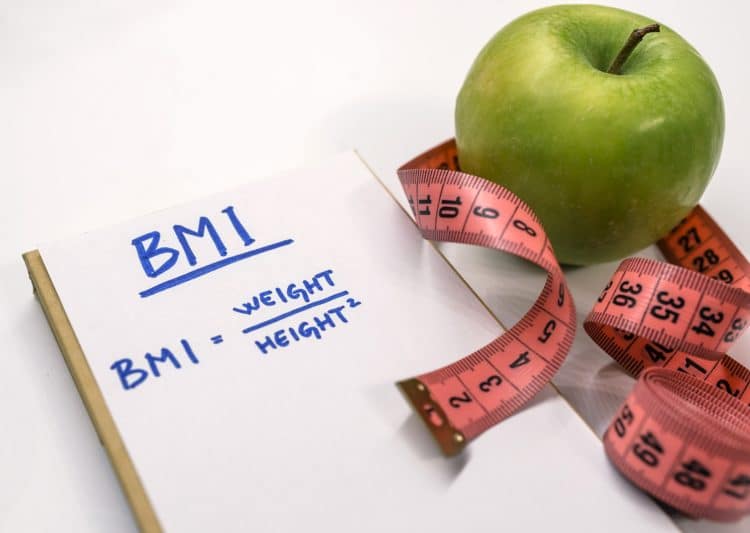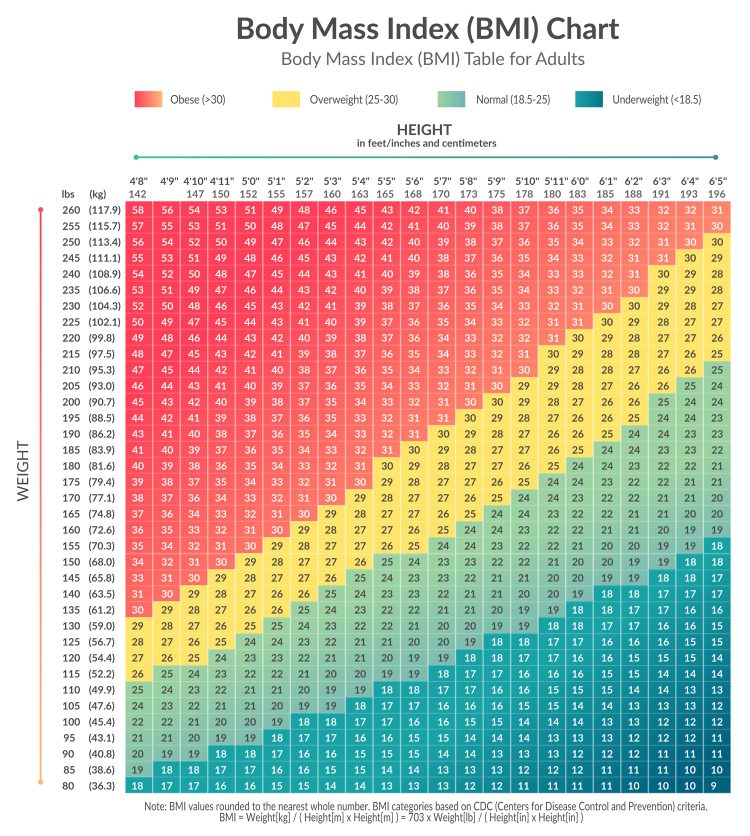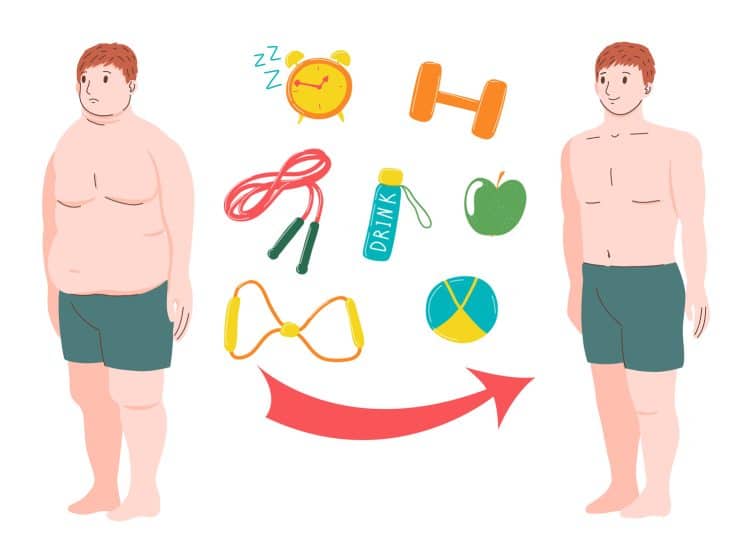If you go to the doctor, the chances are that they will measure your height and your weight. From this, they will tell you whether you are over, under, or the right weight for your height. This is based on something called your Body Mass Index, or BMI for short.
BMI is a standard health test used by the medical profession and a host of other organizations to see if a person is over or underweight. That includes the military, emergency services, and even insurance companies.
But, BMI has its detractors, and some health and fitness experts consider it to be a very inaccurate assessment. They argue that it fails to provide a complete picture of your body mass and composition. And yet, BMI is still widely used.
In this article, we’re going to take an in-depth look at BMI, how it’s calculated, what your results mean, and why it may not be the most useful measure for exercisers. Plus, we’ll also discuss some alternatives.
What is BMI?
So, BMI is short for Body Mass Index. It was first introduced over 200 years ago by Belgian statistician Adolphe Quetelet (1), who wrote about the relationship between height and weight in his paper “A Treatise on Man and the Development of His Faculties.”
However, it wasn’t until the mid-1970s that American Ancel Keys used BMI as a determinant for illness and actually coined the term body mass index (2). It was in his paper “Indices of Relative Weight and Obesity” that Keys and his colleagues discussed the link between height, weight, and health.
You can use an online calculator to determine your BMI or work it out yourself using the following calculations:

Needless to say, using an online calculator is much easier! Once you have got it, you can compare your result to the chart below:
- Underweight = 18.5 or less
- Normal weight = 18.5 – 24.9
- Overweight = 25 – 29.9
- Obese = 30 or more
Your BMI can then be used to determine your risk of certain health and medical conditions. A high BMI (above 25) is linked to an increased risk of (3):
- Type 2 diabetes
- High blood pressure
- Sleep apnea
- Heart disease
- Metabolic syndrome
- Higher risk for some forms of cancer (colon, rectum, gallbladder, kidney, breast)
- Complications during pregnancy
- Osteoarthritis
- Fatty liver disease

It’s also suggested that people with higher BMI scores tend to visit their doctor more often and are more likely to be ill and take time off work due to sickness. Because of this, some medical insurance providers charge more for people with high BMIs (4).
In contrast, a low BMI is linked to an increased risk of (5):
- Increased risk of depression and suicide
- Eating disorders
- Malnutrition
- Vitamin deficiencies
- Developmental issues (particularly in younger males and females)
- Poor immune system
- Lack of energy
- Osteoporosis
- Fertility issues
However, despite its long history and medical prevalence, BMI is not entirely accurate, especially for exercisers. You may be unfairly identified as overweight when you are actually lean and healthy. Why and how? Let’s take a look!
[sc name=”style-blue-box” ]
Tip: Try our BMI, Reverse BMI and TDEE Calculator.
[/sc]
BMI Chart for Men and Women
Use the table by finding the appropriate height in the left-hand column. Navigate to a given weight (in pounds). The number at the top of the column indicates the BMI at that height and weight.

[sc name=”style-blue-box2″ ]
Download the PDF BMI Chart here.
[/sc]
How BMI Can Fail Exercisers
While BMI compares your weight to your height, it does not account for what your weight is made up of – your body composition. You could weigh 200lbs with a body fat percentage of 8% or weigh the same 200lbs with a body fat percentage of 35%.
Needless to say, one would look very different from the other. However, despite these glaring differences, the BMI would be the same.

Obviously, though, being lean reduces your risk of suffering many of the diseases associated with being overweight, even though your BMI may suggest otherwise.
Subsequently, when assessed purely according to BMI, exercisers may be unfairly discriminated against. I know that I’ve been told to lose a few pounds after visiting the doctor’s office despite being leaner than the average person.
A lean bodybuilder, powerlifter, or even just a regular strength training exerciser, may be told that they are overweight or obese despite being anything but. Similarly, a very lean endurance athlete may be labeled as dangerously underweight simply because they have a lower than average body fat percentage.
The good news is that the medical fraternity is slowly starting to realize that BMI is flawed, and studies support the idea that BMI is less useful for exercisers. In one recent study, 299 basketball players were assessed using BMI. Of the 299, 85 scored a BMI of 25 or above (overweight or obese), but only three actually had excess body fat.
BMI also doesn’t take into account hydration. A liter of water weighs one kilo or about 2.2 pounds, so all you need to do is pee or sweat a lot to have a significant impact on your body mass index.
Losing water weight won’t change your body composition (body fat percentage), but being well-hydrated could push your BMI higher. As an exerciser, your hydration levels will vary throughout the day, and with it, your BMI.
Being told you are overweight when you are not can also trigger anxiety and increase stress. After all, most exercisers work out and eat healthily because they want to improve how they look or perform. To be told that your efforts aren’t working by some well-meaning but poorly informed health professional can be a real kick in the crotch. It could even be enough to make you think, “Why am I even bothering” and quit your healthy lifestyle altogether.

Methods that are better than BMI
The good news is that there are several alternatives to BMI that you can use to determine if you really are overweight.
Body composition
Body composition has nothing to do with your height and weight. Instead, it determines what your weight is made up of and provides you with a body fat percentage. There are several methods you can use to assess your BF%, including:
- Hydrostatic weighing – your weight in water compared to your weight on land.
- Skinfold calipers – measuring the thickness of your body fat in different places around your body.
- Dual-Energy X-ray Absorptiometry (DEXA) – a special type of x-ray scan.
- Air Displacement Plethysmography – Bod Pods.
- Bioelectrical impedance – using scales that pass a mild electrical current through your body to measure resistance.
Each of these methods will reveal what percentage of your weight is made up of body fat. There is a difference in accuracy from one method to the next, but DEXA scans are usually considered the most precise. However, bioelectrical impedance is probably the least invasive and easiest to access.
Once you have your body fat percentage, compare it to the chart below:
| Women (% fat) | Men (% fat) | |
| Essential Fat | 10-12% | 2-4% |
| Athletes | 14-20% | 6-13% |
| Fit | 21-24% | 14-17% |
| Acceptable | 25-31% | 18-25% |
| Obese | 32% plus | 25% plus |
Hip to waist ratio
Where you store your body fat may be at least or even more important than how much fat you are carrying. Excess fat around the abdomen, called intra-abdominal fat, is linked to a host of medical conditions, including diabetes and coronary heart disease. Some doctors privately refer to intra-abdominal fat as heart attack fat.
In simple terms, the smaller your waist measurement is, the less intra-abdominal fat you have. The hip to waist ratio compares your waist measurement to the circumference of your hips.
To determine your hip to waist ratio, simply divide your waist measurement by your hip measurement. For example: if you have a waist measurement of 36 inches and a hip circumference of 44 inches, you have a hip to waist ratio of 0.818.
| Female | Male | Health Risk |
| 0.80 or lower | 0.95 or lower | Low health risk |
| 0.81 to 0.84 | 0.96 to 1.0 | Moderate risk |
| 0.85 or higher | 1.0 or higher | High risk |
Athletes with a large “power belly” or a “growth hormone gut” will undoubtedly score poorly on this assessment. Still, it’s a more useful test for most other exercisers than BMI, and it’s also more accessible than most body composition assessments.

Body Adiposity Index (BAI)
Unlike BMI, BAI does not take your weight into consideration. Instead, it estimates your body fat percentage from your hip circumference and your height. BAI is still an educated guess of your body composition, but it’s a better option than BMI for most exercisers because it doesn’t involve your weight. BAI is calculated like this:
Relative Fat Mass Index (RFM)
Similar to BAI, RFM compares your height with your waist circumference. There are two different formulas; one for men and one for women.
- Men: 64 – (20 x height/waist circumference) = RFM
- Women: 76 – (20 x height/waist circumference) = RFM
Like BAI, RFM estimates your body fat percentage, which can then be compared to any body composition chart.
Fitness Volt online body fat calculator: Use our very own online body fat calculator to estimate your body composition and track your progress. It’s free and easy to use.
Related Tools:
- Body Fat Skinfold Calculator
- 3 Skinfold Body Fat Calculator
- 4 Skinfold Body Fat Calculator
- 7 Skinfold Body Fat Calculator
- Grecian Ideal Calculator
- Find Your Body Fat Percentage
- Body Type Quiz
- Calorie Burning Calculators
- Calorie Deficit Calculator
BMI Chart for Men and Women – Wrapping Up
When it comes to BMI, exercisers, and especially men, tend to have a higher score. This can lead to being labeled overweight. If you are more muscular than average, you can be lean and healthy but still come out as obese, even when you not.
That’s because your weight says nothing about your body composition, so being judged on the relationship between your weight and height is not accurate for lifters.
So, don’t worry if you’ve scored badly with BMI; it’s not a precise indicator of your health or your body composition. BAI, RFI, hip to waist, and your actual body fat percentage are all much more useful than your BMI score.
Remember, BMI is over 200 years old, so it’s hardly cutting-edge science. Instead, use a more up to date method that reflects and rewards your hard work in the gym!
References:
1- Encyclopaedia Britannica: Adolphe Quetelet. Belgian astronomer, sociologist, and statistician https://www.britannica.com/biography/Adolphe-Quetelet
2- Science Direct: Indices of relative weight and obesity https://www.sciencedirect.com/science/article/abs/pii/0021968172900276?via%3Dihub
3- US Department of Health and Human Services: Health risks of being overweight https://www.niddk.nih.gov/health-information/weight-management/health-risks-overweight
4- PubMed: The non-linear relationship between BMI and health care costs and the resulting cost fraction attributable to obesity https://www.ncbi.nlm.nih.gov/pmc/articles/PMC5615521/
5- PubMed: What is the impact of underweight on self-reported health trajectories and mortality rates https://www.ncbi.nlm.nih.gov/pmc/articles/PMC5625617/
6- PubMed: Overweight in trained subjects – are we looking at the wrong numbers? https://pubmed.ncbi.nlm.nih.gov/19893101/


